


The TRACE images may be used without restrictions
in publications of any kind. We
appreciate an acknowledgement indicating that
the Transition Region and Coronal Explorer, TRACE,
is a mission of the Stanford-Lockheed Institute for Space
Research, and part of the NASA Small Explorer program. More information on
TRACE and other TRACE images can be found
here.

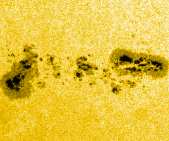 |
Active region 9690 contained an interesting cluster of spots and pores.
This (QuickTime/JPEG; 13.6MB)
movie in white light
shows its evolution from 8 November 2001 at 01:46 UT through 13 November at
6:17 UT. Projection effects make the region appear to expand and shrink as
it crosses the solar central meridian. There are multiple occurrences of
emerging flux, both in the center of the region and at the edge of the
trailing spot group, which contains flux of both polarities
(see the MDI magnetogram at sohowww
or bbso).
 |
  |
These images, taken on 8 February 2001, show how different the corona
looks when observing emission from gas at
1 million Kelvin (top, TRACE 171Å, combining several pointings that
were part of a full-disk mosaic)
or at 2-5 million Kelvin (bottom, Yokhoh/SXT).
The field of view is 700,000 by 350,000 km.
Courtesy Bart De Pontieu.
 |
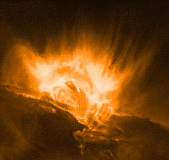 |
On 21 April 2002, TRACE observed an X1.5 flare in Active Region 9906
at the solar limb. The observations, at a high cadance in 195Å
(a mixture of Fe XII at 1.5 million degrees and Fe XXIV at some 10 million
degrees) show some remarkable features that have never been seen before
this close to the Sun; they can be seen in this (QuickTime/JPEG; 15.8MB)
movie (with images
rotated so that north is to the left).
Between 00:50 and 01:05UT there is a faint brightening that rapidly
expands upwards. Then, for about 25 minutes, there is an unusually
hazy, striated, rapidly-evolving
pattern of emission visible above the active region. Around 01:33UT
another new phenomenon is seen: dark blobs move downward into the
bright haze. Some look as one might expect for dark, cool material
sinking through a hot, tenuous material underneath, with some sign
of vortices. The rest of the evolution is more familiar: bright
flare ribbons leaving a bright trail of ``prairie fire'', and arcades of
cooling loops form, with dark, cooled material draining back towards
the solar surface. This running-difference
LASCO movie shows what appear
to be similar infalling clouds, albeit at much greater heights
(from LASCO
web pages at NRL).
|
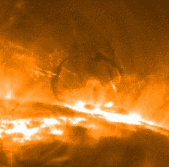 |
The (QuickTime/JPEG; 11.7MB)
movie shows an eruption
which came from Active Region 9885 on 9 April 2002. The
images are rotated so that North is to the right. The movie and
image are in the 195\Aring; (1.5 million degree) pass band.
As the eruption begins, one can
see some dark material lifting off and being blow out.
Courtesy: Dawn Myers.
 |
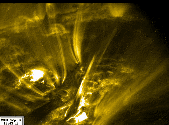 |
On 7 September 2001, TRACE observed this M1.2 flare in Active Region 9601.
The (QuickTime/JPEG; 3.9MB)
movie in 171Å (1 million
degrees) - rotated so that north is to the left - shows a filament
eruption near the bottom of the frame, and a bright loop arcade limbward
of that. These two events, starting at the same time in brightenings
of the low flare ribbons, are clearly related. Note that the loops
high over the bright arcade quiver briefly after the flare - another
one of those loop oscillations. And if you look
closely, there are more loops oscillating ...
 |
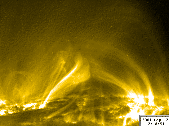 |
On 12 September 2001, TRACE observed Active Region 9611 and surroundings
at the NW limb of the Sun. The image to the right, and the (QuickTime/JPEG;
6.3 MB) movie in 171Å
(with a field of view of 230,000 by 170,000 km) were rotated over +90 degrees,
so that north is to the left.
The movie shows a variety of events, all occurring within a timespan of 5 hrs (see the annotated version to see the labels): A a cusp between the two loops systems on either side of the field of view, perhaps indicating a coronal neutral (or X) point where the field strength goes to zero; B a set of loops oscillating around 14UT; C another set of loops oscillating around 15:40UT; D a filament around the active region with multiple sprays of chromospheric material flowing around and within it; E a set of whirling loops tops around 14:30UT (we have no idea what is actually happening here); and coronal rain around 14:50UT.  |
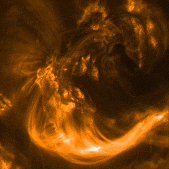 |
On March 12 2002, TRACE observed these cooling loops in Active Region 9866.
The (QuickTime/JPEG; 1.1MB)
movie 195Å
shows the loops appear as they cool into the temperature domain visible
with the TRACE filter used (around 1.5 million Kelvin) .
Some time around 03:10 UT, dark clumps
begin to appear, that slide down the magnetic field: that material is
at temperatures below about 20,000 Kelvin, and dense enough to absorb the
extreme ultraviolet radiation emitted by hot gas behind it.
These loops may be associated with a C3.9 flare listed to have
occurred around 02:24 UT by
NOAA without AR indication.
The movie is shown at half the resolution, with a field of view of
290,000 km square. Courtesy: Dawn Myers.
 |
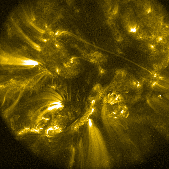 |
On 19 March 2002, around 06 UT, TRACE observed long, cool loops in
the interior of Active Region 9871. The structure persisted for several
hours, although the movie suggests that not always the same field lines
lit up. The distance between the footpoints
of the long, thin thread is 230,000 km. The true loop length
is hard to estimate, because we do not know its height.
 |
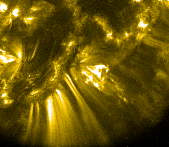 |
New magnetic field emerging onto the solar surface on 20 March 2002
near Active Region 9871 led to an interesting eruption. The newly
emerged field interacts with the pre-existing field, mostly associated
with a sunspot in AR9871. The result is an ejection of mass (and a
spray or surge of cool, dark material somewhat later), that starts just
before 14UT. Bright, hot material (seen in this
Quicktime/JPEG; 3.6MB
movie taken in the 171Å
passband, mostly sensitive to emission from plasma around 1 million degrees)
is thrown upward with projected speeds of some 500 km/s. What is
interesting in this case, is that it appears that the field is
twisting as it rearranges. But we see material move only in one
direction relative to the ejection. We are still thinking about how
to interpret this phenomenon.
The field of view of is 240,000 by 280,000 km; the images were taken
with 2x2 on-chip binning.
 |
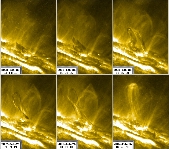 |
On 26 February 2002, TRACE observed a
filament eruption in Active Region 9841 near the edge of the solar disk.
The set of 6 images (rotated over +90 degrees) show the evolution of the cool,
chromospheric material as it is being lifted up to a height of 60,000 km.
Most of the material then slides back to the surface along the changing
magnetic field. The process takes just over an hour, after which a set
of cooling loops is seen to form over the site of the filament
destabilization.
 |
|
| Home | Mission | Instrument | Team | Operations | Results | Images | Movies | Education | Site Info. | |